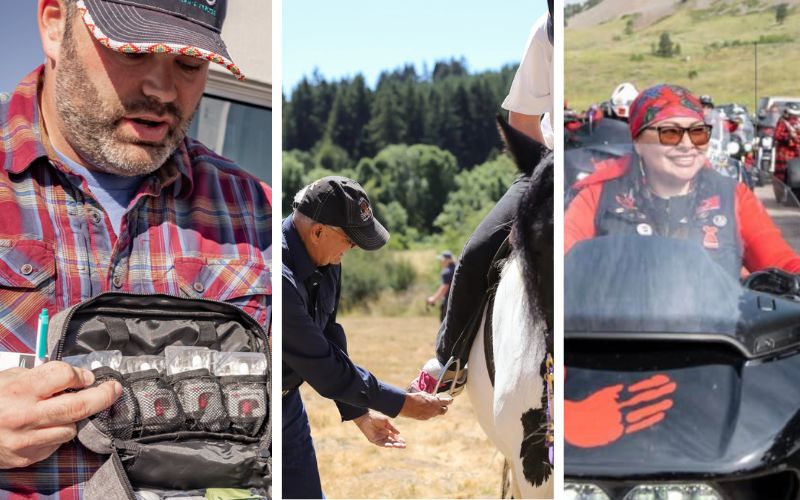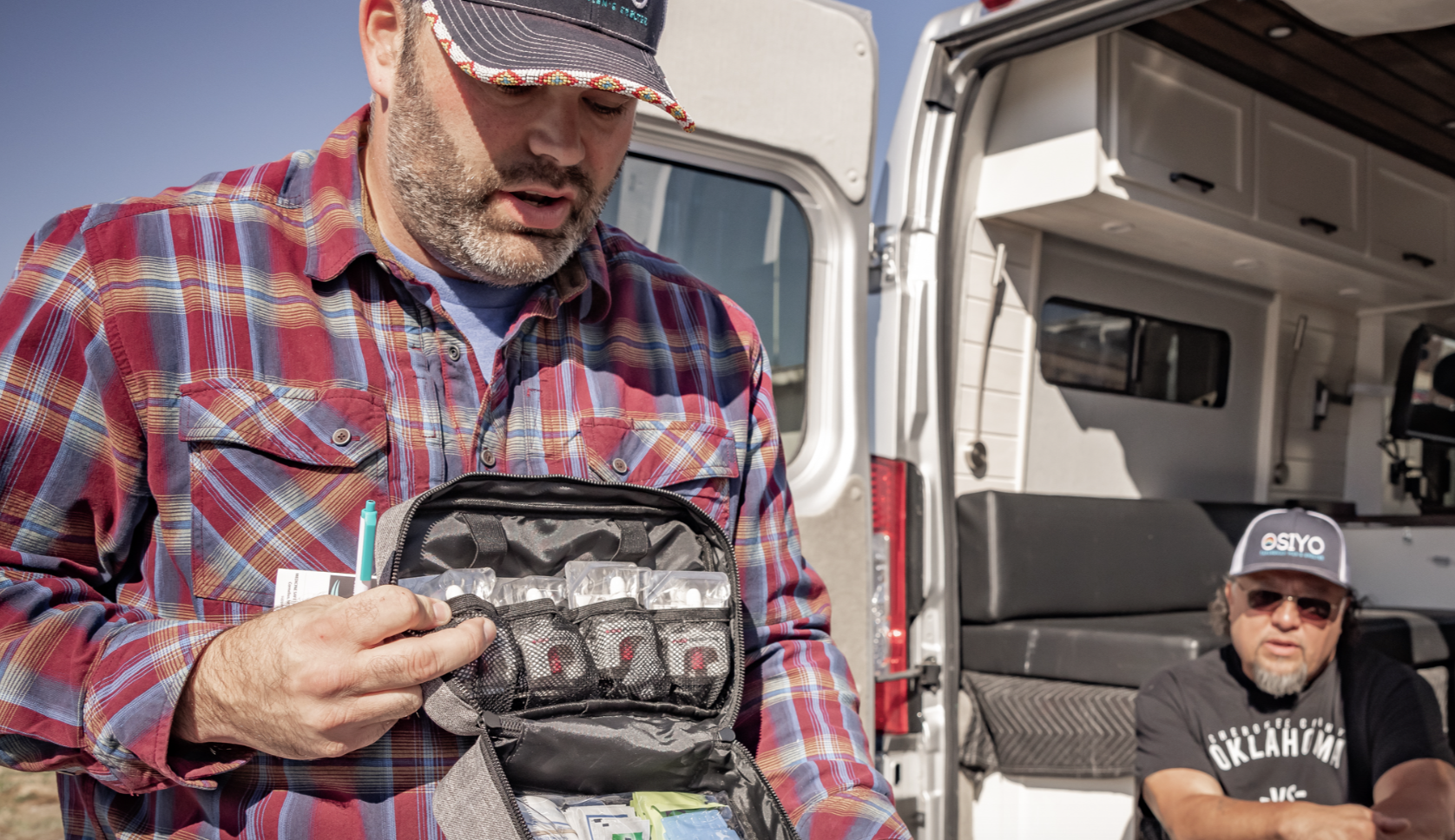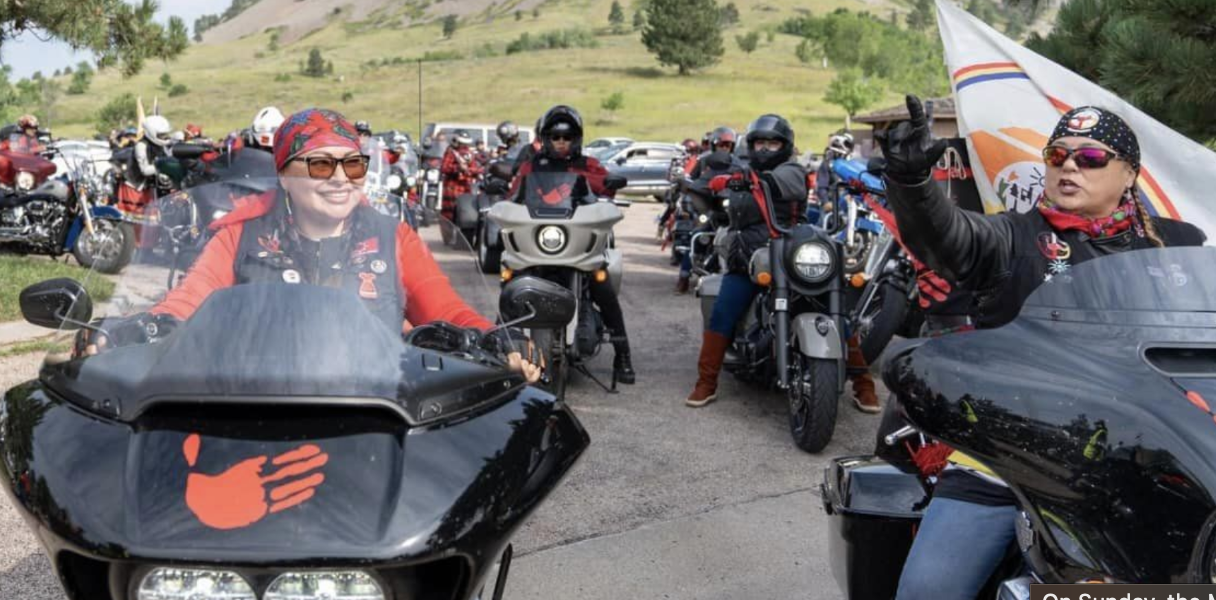
- Details
- By Elyse Wild
While covering the overdose crisis and Missing and Murdered Indigenous People (MMIP), there are a few stories that captured my heart this year.
 Coleman Cox shows items offered at the Cherokee Nation harm-reduction van in Vinita, Oklahoma, on 7 November 2023. (Photograph/Shane Brown for Native News Online)
Coleman Cox shows items offered at the Cherokee Nation harm-reduction van in Vinita, Oklahoma, on 7 November 2023. (Photograph/Shane Brown for Native News Online)
This winter, Native News Online and The Guardian co-published an article I wrote that takes readers to the Cherokee Nation for a ride in the tribe’s mobile harm reduction unit, a van bringing life-saving overdose reduction supplies to areas of the reservation hit hardest by the opioid crisis.
The article spotlights how Native communities were flooded with prescription opioids by pharmaceutical companies and how innovative, Native-led solutions are adapting critical public health strategies to the unique challenges of reservations.
I met people who had faced the worst of themselves in active addiction. Through support from their tribe and connecting to cultural practices once lost, they’ve become beacons of healing in their communities.
‘You Can’t Gangster a Horse’ | Native Youth Connect with Culture to Break Cycles of Addiction
 Spence at a demonstration on Native equine therapy at powwow grounds in the Grand Ronde Valley, introducing attendees to the principles of Native horsemanship. (photo/Elyse Wild)
Spence at a demonstration on Native equine therapy at powwow grounds in the Grand Ronde Valley, introducing attendees to the principles of Native horsemanship. (photo/Elyse Wild)
I was fortunate this year to receive a grant from the Pulitzer Center for Crisis Journalism for a three-part series that examines how tribal communities are proving that blending Indigenous practices with Western medicine creates more effective addiction treatment for their citizens.
Each article examines a component of the addiction care spectrum — prevention, harm reduction, and recovery — through tribal programs and Native-run organizations.
The first article in the series took me to the Native American Rehabilitation Association of the Northwest in Oregon. I spent an afternoon observing a group of at-risk Native American teenage boys in a 90-day youth residential treatment program as they engaged in horse therapy designed around Native traditions and values. Led by 83-year-old elder Jon Spence (Gros Ventre tribe), the boys groomed the horses, walked them, and rode. He taught them how to connect their energy and spirit to the large, powerful animals. Watching the tough facade of boys who had endured the unthinkable fade away with the horses — and Spence — is something I will always carry with me.
SACRED RIDE | Medicine Wheel Riders Travel 2,211 Miles for MMIP Awareness
 (courtesy photo)
(courtesy photo)
This summer, I wrote a profile on the Medicine Wheel Riders, a group of Native women who ride their motorcycles more than 2,200 miles across the West in honor of relatives lost to the Missing and Murdered Indigenous Peoples (MMIP) crisis. Colorful ribbons, each bearing the name of an MMIP, stream from their bikes as they make their way to the final leg of their journey: Bear Butte in Sturgis, S.D., a sacred ground for ceremony and prayer for many Native American tribes since time immemorial. The story demonstrates the healing power of ceremony and the ongoing fight to bring justice to Native people in a system wrought with inequities and failures to address the basic needs of public safety in Indian Country.
More Stories Like This
Native News Weekly (August 25, 2024): D.C. BriefsUS Presidents in Their Own Words Concerning American Indians
Indigenous Actor Elaine Miles Reports Detention by Alleged ICE Agents
Happy Thanksgiving from Native News Online
Coming Up on Native Bidaské: Behind the Animation: Joey Clift Talks “Pow” and Native Storytelling
Help us tell the stories that could save Native languages and food traditions
At a critical moment for Indian Country, Native News Online is embarking on our most ambitious reporting project yet: "Cultivating Culture," a three-year investigation into two forces shaping Native community survival—food sovereignty and language revitalization.
The devastating impact of COVID-19 accelerated the loss of Native elders and with them, irreplaceable cultural knowledge. Yet across tribal communities, innovative leaders are fighting back, reclaiming traditional food systems and breathing new life into Native languages. These aren't just cultural preservation efforts—they're powerful pathways to community health, healing, and resilience.
Our dedicated reporting team will spend three years documenting these stories through on-the-ground reporting in 18 tribal communities, producing over 200 in-depth stories, 18 podcast episodes, and multimedia content that amplifies Indigenous voices. We'll show policymakers, funders, and allies how cultural restoration directly impacts physical and mental wellness while celebrating successful models of sovereignty and self-determination.
This isn't corporate media parachuting into Indian Country for a quick story. This is sustained, relationship-based journalism by Native reporters who understand these communities. It's "Warrior Journalism"—fearless reporting that serves the 5.5 million readers who depend on us for news that mainstream media often ignores.
We need your help right now. While we've secured partial funding, we're still $450,000 short of our three-year budget. Our immediate goal is $25,000 this month to keep this critical work moving forward—funding reporter salaries, travel to remote communities, photography, and the deep reporting these stories deserve.
Every dollar directly supports Indigenous journalists telling Indigenous stories. Whether it's $5 or $50, your contribution ensures these vital narratives of resilience, innovation, and hope don't disappear into silence.
 The stakes couldn't be higher. Native languages are being lost at an alarming rate. Food insecurity plagues many tribal communities. But solutions are emerging, and these stories need to be told.
The stakes couldn't be higher. Native languages are being lost at an alarming rate. Food insecurity plagues many tribal communities. But solutions are emerging, and these stories need to be told.
Support independent Native journalism. Fund the stories that matter.
Levi Rickert (Potawatomi), Editor & Publisher

